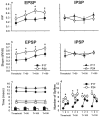Selective developmental increase in the climbing fiber input to the cerebellar interpositus nucleus in rats
- PMID: 15506893
- PMCID: PMC2546608
- DOI: 10.1037/0735-7044.118.5.1111
Selective developmental increase in the climbing fiber input to the cerebellar interpositus nucleus in rats
Abstract
Previous studies have demonstrated that learning-related cerebellar plasticity and stimulus-elicited neuronal activity emerge ontogenetically in parallel with delay eyeblink conditioning in rats. The present study examined cerebellar interpositus field potentials and multiunit neuronal activity evoked by microstimulation of the inferior olive in Postnatal Day 17 and 24 rats. The slope and amplitude of the excitatory postsynaptic potential and the number of evoked multiunit spikes increased with age, whereas the inhibitory postsynaptic potential caused by Purkinje cell input remained stable. These results are consistent with the notion that the postsynaptic depolarization of cerebellar interpositus neurons caused by cerebellar afferents (e.g., the climbing fibers of the inferior olive) is a critical factor contributing to the ontogeny of delay eyeblink conditioning in rats.
Figures


References
-
- Aizenman CD, Huang EJ, Linden DJ. Morphological correlates of intrinsic electrical excitability in neurons of the deep cerebellar nuclei. Journal of Neurophysiology. 2003;89:1738–1747. - PubMed
-
- Aizenman CD, Huang EJ, Manis PB, Linden DJ. Use-dependent changes in synaptic strength at the Purkinje cell to deep nuclear synapse. Progress in Brain Research. 2000;124:247–273. - PubMed
-
- Aizenman CD, Linden DJ. Regulation of the rebound depolarization and spontaneous firing patterns of deep nuclear neurons in slice of rat cerebellum. Journal of Neurophysiology. 1999;82:1697–1709. - PubMed
-
- Carew TJ. Developmental assembly of learning in Aplysia. Trends in Neurosciences. 1989;12:389–394. - PubMed

